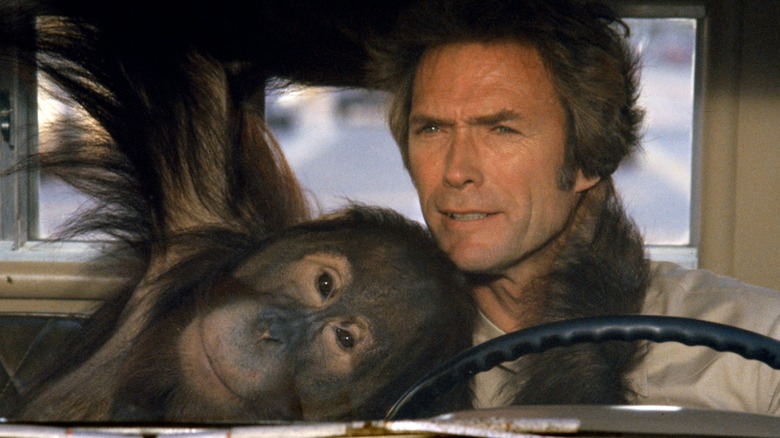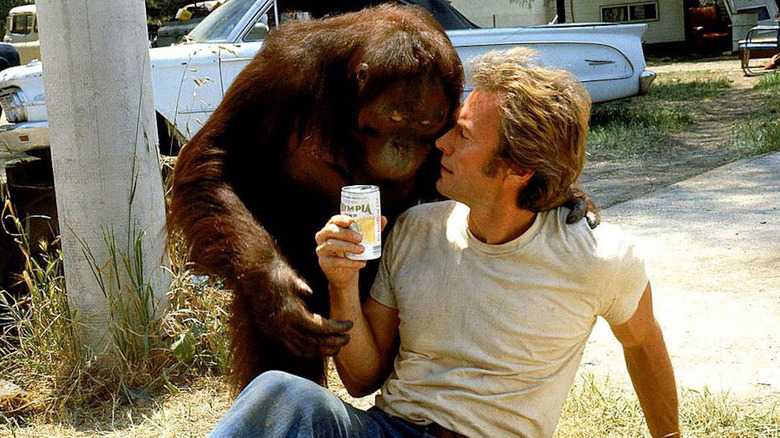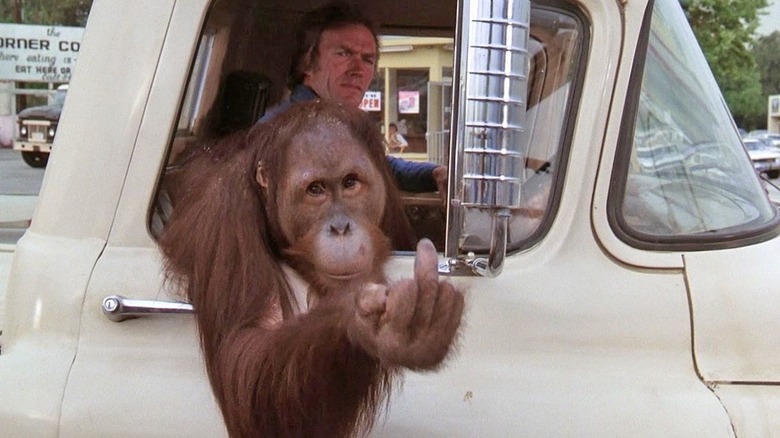Every Which Way But Loose Was A Controversial Project For Clint Eastwood To Choose
Clint Eastwood is justifiably considered one of our greatest living directors. Over his nearly 70-year career, he has received 11 Academy Award nominations and won four times. His revisionist Western "Unforgiven" is widely hailed as the modern apotheosis of the genre. Few filmmakers have left a deeper impact on American cinema. Even fewer have opted to share the screen with a bird-flipping, beer-swilling orangutan that enjoys voiding its bowels in police cars.
It's telling that Eastwood handed off the directorial duties on "Every Which Way But Loose" to his frequent AD James Fargo. You could also argue that Fargo, having done yeoman's work on what currently stands as the best Dirty Harry sequel, "The Enforcer," deserved something a little meatier than a knockabout yarn about a bare-knuckle fighter and his pet orangutan Clyde.
Movies do not get more lowbrow than "Every Which Way But Loose." Actually, they do; the film's sequel, "Any Which Way You Can," makes its predecessor look like "Last Year at Marienbad." In any event, Eastwood knew he was courting something akin to controversy when, two years removed from the triumph of "The Outlaw Josey Wales," he decided to muck about with a Bobby Berosini-trained primate. Wasn't he above this type of thing?
One person's problem picture is another person's box office goldmine
Eastwood, in his typically terse fashion, told Interview Magazine's Graham Fuller that he knew "Every Which Way But Loose" was a "problem picture," but he didn't much care. "I've made problem pictures before," he said, "and sometimes people tell you they're a problem and other times they don't."
He's referring in part to 1977's "The Gauntlet," a relentlessly stupid action film that Eastwood bizarrely bothered to direct. The critics beat him up for it at the time, but audiences turned out. So when "Every Which Way But Loose" came around, he took his own counsel. "You have to lead the audience in different directions, otherwise they might dump you eventually," Eastwood said. "Everybody — my agent, my lawyers — they said don't do 'Every Which Way But Loose,' and even one they saw it, one of the studio execs thought it was going to be a flop. I always thought it was kind of a hip script with the orangutan and stuff. Some people got it and some people didn't, but the public seemed to enjoy it."
The inglorious road to Oscar glory
"Every Which Way But Loose" plays as anything but hip in 2022, but Eastwood wisely clocked the country-Western music craze of the late 1970s, and delivered a PG-rated romp that delighted kids and their parents alike. Watching Clint spar with the hapless motorcycle gang The Black Widows while bopping from one illicit bare-knuckle brawl to another was evidently exactly what audiences wanted to see in 1978. It was the second-highest grossing film of 1978, and its sequel finished fifth at the box office in 1980. These commercial successes helped Eastwood survive a rocky 1980s that, among other commercial disappointments, saw his franchise cash cow, "Dirty Harry," stall out with "The Dead Pool."
The road to "Unforgiven" wasn't pretty (allegedly particularly for the poor orangutan from "Any Which Way You Can"), but, in the long run, Clyde did Clint a right turn.


